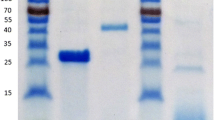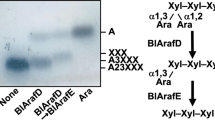Abstract
Arabinoxylan arabinofuranohydrolase-D3 (AXHd3) from Bifidobacterium adolescentis releases only C3-linked arabinose residues from double-substituted xylose residues. A genomic library of B. adolescentis DSM20083 was screened for the presence of the axhD3 gene. Two plasmids were identified containing part of the axhD3 gene. The nucleotide sequences were combined and three open reading frames (ORFs) were found. The first ORF showed high homology with xylanases belonging to family 8 of the glycoside hydrolases and this gene was designated xylA. The second ORF was the axhD3 gene belonging to glycoside hydrolase family 43. The third (partial) ORF coded for a putative carboxylesterase. The axhD3 gene was cloned and expressed in Escherichia coli. Several substrates were employed in the biochemical characterization of recombinant AXHd3. The enzyme showed the highest activity toward wheat arabinoxylan oligosaccharides. In addition, β-xylanase from Trichoderma sp. was able to degrade soluble wheat arabinoxylan polymer to a higher extent, after pretreatment with recombinant AXHd3. Arabinoxylan oligosaccharides incubated with a combination of recombinant AXHd3 and an α-l-arabinofuranosidase from Aspergillus niger did not result in a higher maximal release of arabinose than incubation with these enzymes separately.



Similar content being viewed by others
References
Altschul SF, Madden TI, Schäffer AA, Zhang J, Zhang Z, Miller W, Lipman DJ (1997) Gapped BLAST and PSI-BLAST: a new generation of protein database search programs. Nucleic Acids Res 25:3389–3402
Bradford MM (1976) A rapid and sensitive method for quantification of microgram quantities of protein utilizing the principal of protein–dye binding. Anal Biochem 72:248–254
Campbell JM, Fahey GC, Wolf BW (1997) Selected indigestible oligosaccharides affect large bowel mass, cecal and fecal short-chain fatty acids, pH and microflora in rats. J Nutr 127:130–136
Crittenden R, Karppinen S, Ojanen S, Tenkanen M, Fagerström R, Mättö J, Saarela M, Mattila-Sandholm T, Poutanen K (2002) In vitro fermentation of cereal dietary fibre carbohydrates by probiotic and intestinal bacteria. J Sci Food Agric 82:781–789
Crittenden RG, Playne MJ (1996) Production, properties and application of food-grade oligosaccharides. Trends Food Sci Technol 7:353–361
Crociani F, Alessandrini A, Mucci MM, Biavati B (1994) Degradation of complex carbohydrates by Bifidobacterium spp. Int J Food Microbiol 24:199–210
Degnan BA, Macfarlane GT (1995) Arabinogalactan utilization in continuous cultures of Bifidobacterium longum: effect of co-culture with Bacteroides thetaiotaomicron. Anaerobe 1:103–112
Dubois M, Gilles KA, Hamilton JK, Rebers PA, Smith F (1956) Colorimetric method for determination of sugars and related substances. Anal Chem 23:350–356
Gibson GR (1998) Dietary modulation of the human gut microflora using prebiotics. Brit J Nutr 80:S209–S212
Gibson G, Roberfroid M (1995) Dietary modulation of the human colonic microbiota: introducing the concept of prebiotic. J Nutr 125:1401–1412
Henrissat B (1991) A classification of glycosyl hydrolases based on amino acid sequence similarities. Biochem J 280:309–316
Hopkins MJ, Englyst HN, Macfarlane S, Furrie E, Macfarlane GT, McBain AJ (2003) Degradation of cross-linked and non-cross-linked arabinoxylans by the intestinal microbiota in children. Appl Environ Microbiol 69:6354–6360
Jaskari J, Kontula P, Siitonen A, Jousimies-Somer H, Mattila-Sandholm T, Poutanen K (1998) Oat β-glucan and xylan hydrolysates as selective substrates for Bifidobacterium and Lactobacillus strains. Appl Microbiol Biotechnol 49:175–181
Laemmli UK (1970) Cleavage of structural proteins during the assembly of the head of bacteriophage T4. Nature 227:680–685
Lorenz WW, Wiegel J (1997) Isolation, analysis, and expression of two genes from Thermoanaerobacterium sp. strain JW/SL YS485: a β-xylosidase and a novel acetyl xylan esterase with cephalosporin C deacetylase activity. J Bacteriol 179:5436–5441
Lowry OH, Rosebrough NJ, Farr AL, Randall RJ (1951) Protein measurement with the Folin Phenol reagent. J Biol Chem 193:265–275
Margolles A, De Los Reyes-Gavilán CG (2003) Purification and functional characterization of a novel alpha-l-arabinofuranosidase from Bifidobacterium longum B667. Appl Environ Microbiol 69:5096–5103
Okazaki M, Fujikawa S, Matsumoto N (1990) Effect of xylooligosaccharide on the growth of bifidobacteria. Bifidobacteria Microflora 9:77–86
Pitson SM, Voragen AGJ, Beldman G (1996) Stereochemical course of hydrolysis catalyzed by arabinofuranosyl hydrolases. FEBS Lett 398:7–11
Schell MA, Karmirantzou M, Snel B, Vilanova D, Berger B, Pessi G, Zwahlen MC, Desiere F, Bork P, Delley M, Pridmore RD, Arigoni F (2002) The genome sequence of Bifidobacterium longum reflects its adaptation to the human gastrointestinal tract. Proc Natl Acad Sci USA 99:14422–14427
Shin H-Y, Lee J-H, Lee J-Y, Han Y-O, Han MJ, Kim D-H (2003a) Purification and characterization of ginsenoside Ra-hydrolyzing β-d-xylosidase from Bifidobacterium breve K-110, a human intestinal anaerobic bacterium. Biol Pharm Bull 26:1170–1173
Shin H-Y, Park S-Y, Sung JH, Kim D-H (2003b) Purification and characterization of α-l-arabinopyranosidase and α-l-arabinofuranosidase from Bifidobacterium breve K-110, a human intestinal anaerobic bacterium metabolizing ginsenoside Rb2 and Rc. Appl Environ Microbiol 69:7116–7123
Van den Broek LAM, Struijs K, Verdoes JC, Beldman G, Voragen AGJ (2003) Cloning and characterization of two α-glucosidases from Bifidobacterium adolescentis DSM20083. Appl Microbiol Biotechnol 61:55–60
Van den Broek LAM, Ton J, Verdoes JC, Beldman G, Voragen AGJ (1999) Synthesis of α-galacto-oligosaccharides by a cloned α-galactosidase from Bifidobacterium adolescentis. Biotechnol Lett 21:441–445
Van Laere KMJ, Beldman G, Voragen AGJ (1997) A new arabinofuranohydrolase from Bifidobacterium adolescentis able to remove arabinofuranosyl residues from double-substituted xylose units in arabinoxylan. Appl Microbiol Biotechnol 47:231–235
Van Laere KMJ, Hartemink R, Bosveld M, Schols HA, Voragen AGJ (2000) Fermentation of plant cell wall derived polysaccharides and their corresponding oligosaccharides by intestinal bacteria. J Agric Food Chem 48:1644–1652
Van Laere KMJ, Voragen CHL, Kroef T, Van den Broek LAM, Beldman G, Voragen AGJ (1999) Purification and mode of action of two different arabinoxylan arabinofuranohydrolases from Bifidobacterium adolescentis DSM 20083. Appl Microbiol Biotechnol 51:606–613
Vásquez MJ, Alonso JL, Domínguez H, Parajó JC (2000) Xylooligosaccharides: manufacture and applications. Trend Food Sci Technol 11:387–393
Vincent F, Charnock SJ, Verschueren KHG, Turkenburg JP, Scott DJ, Offen WA, Roberts S, Pell G, Gilbert HJ, Davies GJ, Brannigan JA (2003) Multifunctional xylooliogsaccharide/cephalosporin C deacetylase revealed by the hexameric structure of the Bacillus subtilis enzyme at 1.9 Å resolution. J Mol Biol 330:593–606
Author information
Authors and Affiliations
Corresponding author
Rights and permissions
About this article
Cite this article
van den Broek, L.A.M., Lloyd, R.M., Beldman, G. et al. Cloning and characterization of arabinoxylan arabinofuranohydrolase-D3 (AXHd3) from Bifidobacterium adolescentis DSM20083. Appl Microbiol Biotechnol 67, 641–647 (2005). https://doi.org/10.1007/s00253-004-1850-9
Received:
Revised:
Accepted:
Published:
Issue Date:
DOI: https://doi.org/10.1007/s00253-004-1850-9




